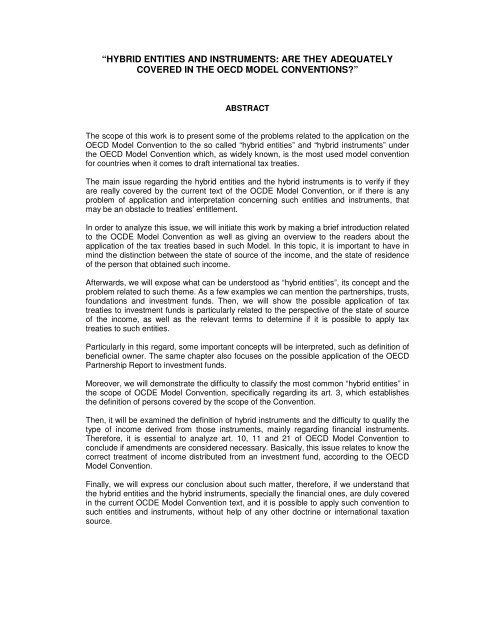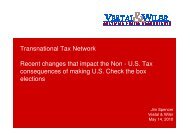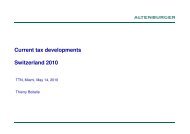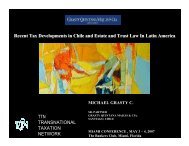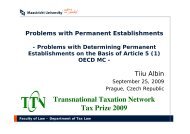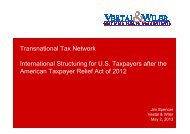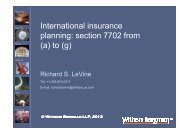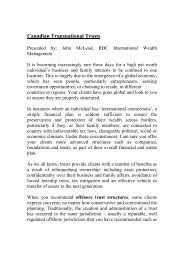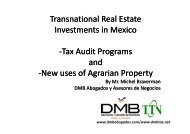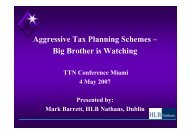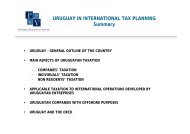hybrid entities and instruments: are they adequately covered in the ...
hybrid entities and instruments: are they adequately covered in the ...
hybrid entities and instruments: are they adequately covered in the ...
You also want an ePaper? Increase the reach of your titles
YUMPU automatically turns print PDFs into web optimized ePapers that Google loves.
“HYBRID ENTITIES AND INSTRUMENTS: ARE THEY ADEQUATELY<br />
COVERED IN THE OECD MODEL CONVENTIONS?”<br />
ABSTRACT<br />
The scope of this work is to present some of <strong>the</strong> problems related to <strong>the</strong> application on <strong>the</strong><br />
OECD Model Convention to <strong>the</strong> so called “<strong>hybrid</strong> <strong>entities</strong>” <strong>and</strong> “<strong>hybrid</strong> <strong><strong>in</strong>struments</strong>” under<br />
<strong>the</strong> OECD Model Convention which, as widely known, is <strong>the</strong> most used model convention<br />
for countries when it comes to draft <strong>in</strong>ternational tax treaties.<br />
The ma<strong>in</strong> issue regard<strong>in</strong>g <strong>the</strong> <strong>hybrid</strong> <strong>entities</strong> <strong>and</strong> <strong>the</strong> <strong>hybrid</strong> <strong><strong>in</strong>struments</strong> is to verify if <strong><strong>the</strong>y</strong><br />
<strong>are</strong> really <strong>covered</strong> by <strong>the</strong> current text of <strong>the</strong> OCDE Model Convention, or if <strong>the</strong>re is any<br />
problem of application <strong>and</strong> <strong>in</strong>terpretation concern<strong>in</strong>g such <strong>entities</strong> <strong>and</strong> <strong><strong>in</strong>struments</strong>, that<br />
may be an obstacle to treaties’ entitlement.<br />
In order to analyze this issue, we will <strong>in</strong>itiate this work by mak<strong>in</strong>g a brief <strong>in</strong>troduction related<br />
to <strong>the</strong> OCDE Model Convention as well as giv<strong>in</strong>g an overview to <strong>the</strong> readers about <strong>the</strong><br />
application of <strong>the</strong> tax treaties based <strong>in</strong> such Model. In this topic, it is important to have <strong>in</strong><br />
m<strong>in</strong>d <strong>the</strong> dist<strong>in</strong>ction between <strong>the</strong> state of source of <strong>the</strong> <strong>in</strong>come, <strong>and</strong> <strong>the</strong> state of residence<br />
of <strong>the</strong> person that obta<strong>in</strong>ed such <strong>in</strong>come.<br />
Afterwards, we will expose what can be understood as “<strong>hybrid</strong> <strong>entities</strong>”, its concept <strong>and</strong> <strong>the</strong><br />
problem related to such <strong>the</strong>me. As a few examples we can mention <strong>the</strong> partnerships, trusts,<br />
foundations <strong>and</strong> <strong>in</strong>vestment funds. Then, we will show <strong>the</strong> possible application of tax<br />
treaties to <strong>in</strong>vestment funds is particularly related to <strong>the</strong> perspective of <strong>the</strong> state of source<br />
of <strong>the</strong> <strong>in</strong>come, as well as <strong>the</strong> relevant terms to determ<strong>in</strong>e if it is possible to apply tax<br />
treaties to such <strong>entities</strong>.<br />
Particularly <strong>in</strong> this regard, some important concepts will be <strong>in</strong>terpreted, such as def<strong>in</strong>ition of<br />
beneficial owner. The same chapter also focuses on <strong>the</strong> possible application of <strong>the</strong> OECD<br />
Partnership Report to <strong>in</strong>vestment funds.<br />
Moreover, we will demonstrate <strong>the</strong> difficulty to classify <strong>the</strong> most common “<strong>hybrid</strong> <strong>entities</strong>” <strong>in</strong><br />
<strong>the</strong> scope of OCDE Model Convention, specifically regard<strong>in</strong>g its art. 3, which establishes<br />
<strong>the</strong> def<strong>in</strong>ition of persons <strong>covered</strong> by <strong>the</strong> scope of <strong>the</strong> Convention.<br />
Then, it will be exam<strong>in</strong>ed <strong>the</strong> def<strong>in</strong>ition of <strong>hybrid</strong> <strong><strong>in</strong>struments</strong> <strong>and</strong> <strong>the</strong> difficulty to qualify <strong>the</strong><br />
type of <strong>in</strong>come derived from those <strong><strong>in</strong>struments</strong>, ma<strong>in</strong>ly regard<strong>in</strong>g f<strong>in</strong>ancial <strong><strong>in</strong>struments</strong>.<br />
Therefore, it is essential to analyze art. 10, 11 <strong>and</strong> 21 of OECD Model Convention to<br />
conclude if amendments <strong>are</strong> considered necessary. Basically, this issue relates to know <strong>the</strong><br />
correct treatment of <strong>in</strong>come distributed from an <strong>in</strong>vestment fund, accord<strong>in</strong>g to <strong>the</strong> OECD<br />
Model Convention.<br />
F<strong>in</strong>ally, we will express our conclusion about such matter, <strong>the</strong>refore, if we underst<strong>and</strong> that<br />
<strong>the</strong> <strong>hybrid</strong> <strong>entities</strong> <strong>and</strong> <strong>the</strong> <strong>hybrid</strong> <strong><strong>in</strong>struments</strong>, specially <strong>the</strong> f<strong>in</strong>ancial ones, <strong>are</strong> duly <strong>covered</strong><br />
<strong>in</strong> <strong>the</strong> current OCDE Model Convention text, <strong>and</strong> it is possible to apply such convention to<br />
such <strong>entities</strong> <strong>and</strong> <strong><strong>in</strong>struments</strong>, without help of any o<strong>the</strong>r doctr<strong>in</strong>e or <strong>in</strong>ternational taxation<br />
source.
I. OCDE MODEL CONVENTION AND HYBRID ENTITIES: ANALYZIS OF ITS<br />
APPLICABLE ARTICLES<br />
In this chapter we will analyze <strong>the</strong> application of <strong>the</strong> OECD Model Tax Convention (“OECD<br />
MC”) as well as its Commentaries (“Commentaries”) to “<strong>hybrid</strong> <strong>entities</strong>.” The term “<strong>hybrid</strong><br />
entity” can be understood as any entity that is treated, for <strong>in</strong>come tax purposes, as a flowthrough<br />
vehicle. Normally, <strong><strong>the</strong>y</strong> <strong>are</strong> considered as a transp<strong>are</strong>nt entity under <strong>the</strong> domestic<br />
law of one country <strong>and</strong> as a separate taxable entity (non-transp<strong>are</strong>nt entity) under <strong>the</strong><br />
domestic law of ano<strong>the</strong>r country. One of <strong>the</strong> most common examples is <strong>the</strong> partnership, a<br />
entity that can be treated as transp<strong>are</strong>nt on non-transp<strong>are</strong>nt <strong>in</strong> one or <strong>in</strong> both countries <strong>and</strong><br />
<strong>the</strong>refore gives rise to a classification conflict.<br />
Additionally, <strong>entities</strong> can also be considered as <strong>hybrid</strong>s <strong>in</strong> <strong>the</strong> sense that <strong><strong>the</strong>y</strong> comb<strong>in</strong>e<br />
private law features conventionally associated with a corporation or a partnership. In this<br />
sense, <strong>the</strong> application of treaty provisions to partnerships has proven to be very difficult <strong>and</strong><br />
debatable, because often it can be generated irreconcilable results depend<strong>in</strong>g on <strong>the</strong><br />
treatment of a partnership under <strong>the</strong> domestic law of a Contract<strong>in</strong>g State of <strong>the</strong> treaty as<br />
ei<strong>the</strong>r a taxable entity separate from <strong>the</strong> partners or a flow-through vehicle with no<br />
<strong>in</strong>dividual taxable capacity.<br />
In order to try to clarify more such matter, <strong>the</strong> OECD created a Partnership Report to<br />
approach <strong>the</strong> application of <strong>the</strong> OECD model tax convention to partnerships, <strong>and</strong> suggest<br />
possible solutions to <strong>the</strong>se problems.<br />
Accord<strong>in</strong>g to VAN RAAD 1 , <strong>the</strong> OECD Partnership report also provides some important<br />
recommendations for <strong>the</strong> amendment of certa<strong>in</strong> articles of <strong>the</strong> model convention <strong>and</strong> some<br />
of <strong>the</strong> related commentary. Be<strong>in</strong>g that said, it clearly demonstrates that <strong>the</strong> exist<strong>in</strong>g text of<br />
OCDE Model Convention is far from resolv<strong>in</strong>g <strong>the</strong> conflicts of application, <strong>in</strong>terpretation <strong>and</strong><br />
qualification of <strong>hybrid</strong> <strong>entities</strong> such as partnerships.<br />
O<strong>the</strong>r very used form of <strong>hybrid</strong> entity is <strong>the</strong> <strong>in</strong>vestment fund. There <strong>are</strong> many forms under<br />
which an <strong>in</strong>vestment fund may be organized, <strong>and</strong> <strong><strong>the</strong>y</strong> <strong>are</strong> crucially l<strong>in</strong>ked to its possible<br />
entitlement to <strong>the</strong> benefits of tax treaties, specially those that adopt <strong>the</strong> OCDE Model<br />
Convention.<br />
In order to hav<strong>in</strong>g granted such benefits, an <strong>in</strong>vestment fund must be considered both a<br />
“person” <strong>and</strong> a “resident” <strong>in</strong> accordance with <strong>the</strong> def<strong>in</strong>itions of such terms as laid down <strong>in</strong><br />
<strong>the</strong> relevant provision of <strong>the</strong> Model Convention. In this respect, an <strong>in</strong>vestment fund<br />
organized under corporate law is considered to fall with<strong>in</strong> <strong>the</strong> mean<strong>in</strong>g of “company” as<br />
def<strong>in</strong>ed <strong>in</strong> art. 3(1)(a), or whe<strong>the</strong>r <strong>the</strong> entity lacks of <strong>the</strong> requirements of a company it may<br />
still be encompassed <strong>in</strong> <strong>the</strong> def<strong>in</strong>ition of “body corporate” provided that is treated as a<br />
company for tax purposes.<br />
Hence, <strong>the</strong> mean<strong>in</strong>g of <strong>the</strong> term “body of persons” is extremely crucial for <strong>the</strong> application of<br />
OECD MC to all <strong>hybrid</strong> <strong>entities</strong>. Never<strong>the</strong>less, <strong>the</strong>re is ano<strong>the</strong>r requirement to enable <strong>the</strong><br />
treaties’ benefits entitlement to <strong>entities</strong> like <strong>the</strong> <strong>in</strong>vestment funds or partnerships, specially<br />
concern<strong>in</strong>g <strong>the</strong> possibility of <strong>the</strong>ir <strong>in</strong>clusion <strong>in</strong> <strong>the</strong> term “resident”.<br />
In order to be considered as a resident for treaty purposes <strong>the</strong>re is a doubt emerg<strong>in</strong>g from<br />
<strong>the</strong> <strong>in</strong>terpretation of <strong>the</strong> term “liable to tax”, that may be understood ei<strong>the</strong>r as a “potential<br />
taxation” of “<strong>the</strong> actual taxation” by <strong>in</strong>comes received by <strong>the</strong> <strong>hybrid</strong> <strong>entities</strong>. Though,<br />
mak<strong>in</strong>g such <strong>in</strong>terpretation even more complicated, <strong>the</strong>re <strong>are</strong> some cases that aggravate<br />
this <strong>in</strong>terpretation <strong>and</strong> def<strong>in</strong>ition problem. One of <strong>the</strong>se examples is when <strong>the</strong> <strong>hybrid</strong> entity<br />
1 VAN RAAD, Kees <strong>and</strong> DOERNBERG, Richard. “Hybrid Entities <strong>and</strong> <strong>the</strong> U. S. Model Income Tax Treaty”. August, 23,<br />
1999. 19 Tax Notes International, pg. 745-757<br />
2
is considered as fiscally transp<strong>are</strong>nt, s<strong>in</strong>ce <strong>the</strong> issues to be solved, <strong>in</strong> order to consider it as<br />
a resident for treaty purposes, <strong>are</strong> more <strong>in</strong>tricate.<br />
None<strong>the</strong>less, after deep analysis of <strong>the</strong> OECD Commentaries regard<strong>in</strong>g such matter, we<br />
agree with PALLESI 2 when <strong>the</strong> author states that a transp<strong>are</strong>nt entity may be entitled to<br />
treaty benefits <strong>and</strong>, <strong>the</strong>refore, be considered as resident for treaty purposes, even though it<br />
may appear that such wide <strong>in</strong>terpretation goes beyond <strong>the</strong> literal <strong>and</strong> technical mean<strong>in</strong>g of<br />
<strong>the</strong> word<strong>in</strong>g of art. 4 of <strong>the</strong> OECD MC.<br />
Unfortunately, <strong>the</strong>re is no explicit mention of this underst<strong>and</strong><strong>in</strong>g, what makes it difficult to<br />
apply <strong>the</strong> treaties to partnerships, <strong>in</strong>vestment funds, trusts <strong>and</strong> o<strong>the</strong>rs. In this sense, we<br />
believe that a written express <strong>in</strong>clusion of such underst<strong>and</strong><strong>in</strong>g would be an important<br />
start<strong>in</strong>g po<strong>in</strong>t to achieve <strong>the</strong> scope of elim<strong>in</strong>at<strong>in</strong>g <strong>the</strong> practices that discourages crossborder<br />
activities with all those <strong>hybrid</strong> <strong>entities</strong>, specially to partnerships <strong>and</strong> <strong>in</strong>vestment<br />
funds.<br />
To summarize all <strong>the</strong> requirements above described to verify if <strong>hybrid</strong> <strong>entities</strong> <strong>are</strong> entitled to<br />
treaty benefits, we can affirm that <strong>the</strong> follow<strong>in</strong>g questions shall be answered:<br />
(i)<br />
(ii)<br />
(iii)<br />
(iv)<br />
does <strong>the</strong> term “person” <strong>and</strong> “body of persons”, by <strong>the</strong> current word<strong>in</strong>g of <strong>the</strong><br />
OECD MC, <strong>in</strong>clude <strong>the</strong> <strong>hybrid</strong> <strong>entities</strong> such as partnerships, <strong>in</strong>vestment funds,<br />
trusts, foundations <strong>and</strong> o<strong>the</strong>r?<br />
Are such <strong>entities</strong> considered as “liable to tax”;<br />
may <strong><strong>the</strong>y</strong> be considered as <strong>the</strong> beneficial owners of <strong>the</strong> <strong>in</strong>come received<br />
accord<strong>in</strong>g to art. 10, 11 <strong>and</strong> 12 of OECD MC? And<br />
Can <strong>the</strong> <strong>in</strong>come received by such <strong>entities</strong> be considered as “paid to” such<br />
vehicles?<br />
I.A APPLICATION OF REQUIREMENTS TO THE TREATY ENTITLEMENT FOR<br />
HYBRID ENTITIES<br />
Firstly, <strong>the</strong> OECD MC def<strong>in</strong>ition of “persons” <strong>and</strong> “resident” <strong>are</strong> very important to def<strong>in</strong>e if<br />
<strong>the</strong> treaty can be applied to such <strong>entities</strong>. On <strong>the</strong> subject of <strong>the</strong> concept of persons, as<br />
def<strong>in</strong>ed <strong>in</strong> art. 3(1)(a) of <strong>the</strong> OECD MC, when such entity is organized under a contractual<br />
arrangement it may not be <strong>in</strong>cluded <strong>in</strong> such def<strong>in</strong>ition of “body of persons”.<br />
Moreover, “person” is <strong>the</strong>n def<strong>in</strong>ed by art. 3(1)(a) “as <strong>in</strong>clud<strong>in</strong>g an <strong>in</strong>dividual, a company<br />
<strong>and</strong> any o<strong>the</strong>r body of persons”. Partnerships <strong>and</strong> foundations <strong>are</strong>, accord<strong>in</strong>g to <strong>the</strong><br />
Commentary, also <strong>in</strong>cluded <strong>in</strong> such def<strong>in</strong>ition. The Commentary def<strong>in</strong>ed “body corporate”<br />
as: “ any o<strong>the</strong>r taxable unit, although not <strong>in</strong>corporated, that is treated as a body corporate<br />
accord<strong>in</strong>g to <strong>the</strong> tax law of <strong>the</strong> Contract<strong>in</strong>g State <strong>in</strong> which it is organized”.<br />
<strong>in</strong> view of that, <strong>hybrid</strong> <strong>entities</strong> may not be considered as <strong>in</strong>dividuals, but may better be<br />
assimilated to companies or body of persons. Still, <strong>in</strong> which def<strong>in</strong>ition such <strong>entities</strong> fall <strong>in</strong><br />
depends on <strong>the</strong> legal structure <strong><strong>the</strong>y</strong> have adopted under <strong>the</strong>ir domestic law. For this<br />
reason, it may be concluded that if a <strong>hybrid</strong> entity is, under its domestic law, considered as<br />
a corporation it def<strong>in</strong>itely fits <strong>in</strong> <strong>the</strong> def<strong>in</strong>ition of “company” mentioned <strong>in</strong> <strong>the</strong> OCDE MC<br />
it should be underl<strong>in</strong>ed that <strong>the</strong> Commentary to art 3, <strong>in</strong> its paragraph 2 specifies, for<br />
partnerships, that “where it is not <strong>the</strong> case (<strong><strong>the</strong>y</strong> have to be considered as persons)<br />
because <strong><strong>the</strong>y</strong> constitute o<strong>the</strong>r body of persons”.<br />
2 PALLESI, Niccolo. “The application of tax treaties to <strong>in</strong>vestment funds”. University of California, Berkley, 2007.<br />
Available at Berkley Eletronic Press (bepress) <strong>in</strong> 12.07.08<br />
3
Additionally, due to <strong>the</strong> wide def<strong>in</strong>ition of “body corporate” given <strong>in</strong> <strong>the</strong> Commentary, also<br />
an entity, “although not <strong>in</strong>corporated”, may fit <strong>in</strong> <strong>the</strong> above def<strong>in</strong>ition, <strong>and</strong> thus be treated as<br />
a company, provided that is treated as such for tax purposes 3 .<br />
In conclusion, <strong>the</strong> condition for qualify<strong>in</strong>g any <strong>hybrid</strong> entity as a person, accord<strong>in</strong>g to OECD<br />
MC, will depend if <strong>the</strong> entity is treated <strong>in</strong> its country of establishment as a body or person<br />
(company), s<strong>in</strong>ce this term is def<strong>in</strong>ed nei<strong>the</strong>r <strong>in</strong> <strong>the</strong> Model Convention nor <strong>in</strong> <strong>the</strong><br />
Commentary.<br />
Conversely, it is commonly accepted that some <strong>hybrid</strong> <strong>entities</strong> like <strong>in</strong>vestment funds may<br />
constitute an “association of person”; not a “body of person” because <strong><strong>the</strong>y</strong> lack of<br />
<strong>in</strong>dependent identity (i.e. legal personality) from <strong>the</strong> participants-members. While <strong>the</strong> OCDE<br />
MC does not amend <strong>the</strong> text of <strong>the</strong> Model Convention, <strong>the</strong>re will rema<strong>in</strong> doubts when it<br />
comes to such issue. However, if <strong>the</strong> entity is not a company but is treated as such for tax<br />
purpose it may be <strong>in</strong>cluded of <strong>the</strong> def<strong>in</strong>ition of body corporate accord<strong>in</strong>g to <strong>the</strong> word<strong>in</strong>g of<br />
paragraph 2 of <strong>the</strong> Commentary on art. 3.<br />
In order to reach this conclusion both paragraph 2 of <strong>the</strong> Commentary on art.3, which<br />
expressly mentions that <strong>the</strong> terms “persons is to be used <strong>in</strong> a wide sense”, <strong>and</strong> <strong>the</strong> General<br />
Report on <strong>the</strong> IFA Congress <strong>in</strong> 1997 accord<strong>in</strong>g to which, if specific requirements <strong>are</strong> met,<br />
such funds <strong>are</strong> regarded as persons for treaty purposes.<br />
As per def<strong>in</strong>ition of resident <strong>in</strong> art. 4(1) of OECD MC, it does not say when an <strong>in</strong>vestment<br />
fund or a partnership is considered as a taxable entity that <strong><strong>the</strong>y</strong> necessarily <strong>are</strong> considered<br />
as a resident for treaty purposes. But, as above mentioned, if <strong>the</strong> entity is treated as such<br />
for tax purpose it may be <strong>in</strong>cluded of <strong>the</strong> def<strong>in</strong>ition of body corporate, <strong>and</strong>, might be<br />
considered, <strong>the</strong>refore, as resident for tax purposes too.<br />
Considered that all <strong>hybrid</strong> <strong>entities</strong> such as <strong>in</strong>vestment funds, partnerships <strong>and</strong> trusts may<br />
be considered as a “person” for treaty purposes, it is necessary to check whe<strong>the</strong>r those<br />
<strong>entities</strong> may be assessed as a “resident” <strong>in</strong> <strong>the</strong> mean<strong>in</strong>g of art. 4(1) of <strong>the</strong> OECD MC. The<br />
problems concern<strong>in</strong>g <strong>the</strong> <strong>in</strong>terpretation of this article regards <strong>the</strong> different def<strong>in</strong>ition that<br />
may be given to <strong>the</strong> term “liable to tax”. The def<strong>in</strong>ition of “resident” of a Contract<strong>in</strong>g State<br />
expressed by <strong>the</strong> Model Convention means that <strong>the</strong> person has to be subject to worldwide<br />
taxation <strong>in</strong> at least one of <strong>the</strong> two Contract<strong>in</strong>g States.<br />
Never<strong>the</strong>less, ano<strong>the</strong>r issues arise <strong>in</strong> def<strong>in</strong><strong>in</strong>g <strong>the</strong> term “liable to tax”. Accord<strong>in</strong>g to a wide<br />
<strong>in</strong>terpretation, <strong>the</strong> term “liable to tax” would imply that a “potential taxation” would be<br />
sufficient <strong>in</strong> order to be eligible for treaty benefits. By contrast, accord<strong>in</strong>g to a narrower<br />
<strong>in</strong>terpretation, <strong>the</strong> term “liable to tax” would imply that an “actual taxation” is <strong>the</strong> “condition<br />
s<strong>in</strong>e qua non” for treaty entitlement. Additionally, we believe that such term should be<br />
<strong>in</strong>terpreted <strong>in</strong> a wide sense bear<strong>in</strong>g <strong>in</strong> m<strong>in</strong>d <strong>the</strong> “objective <strong>and</strong> purpose of <strong>the</strong> Convention”.<br />
In addition, <strong>the</strong> mean<strong>in</strong>g of “liable to tax” has to be also analyzed. Entities that <strong>are</strong><br />
potentially liable to tax (but actually <strong>are</strong> not) such as tax-exempt <strong>entities</strong> should not be<br />
assessed as resident for treaty purposes. On <strong>the</strong> o<strong>the</strong>r h<strong>and</strong>, when an entity is disregarded<br />
for tax purposes, <strong>the</strong>refore considered as transp<strong>are</strong>nt, it will never become potentially<br />
taxable. As a result, accord<strong>in</strong>g to PALLESI, <strong>the</strong> only way through which transp<strong>are</strong>nt<br />
vehicles may be entitled to treaty benefits is by <strong>the</strong> <strong>in</strong>sertion of a specific provision deal<strong>in</strong>g<br />
with <strong>the</strong> matter <strong>in</strong> <strong>the</strong> OECD MC or <strong>in</strong> its Commentary.<br />
In this respect, it should be mentioned that <strong>the</strong> OECD Commentary <strong>in</strong> its paragraph 8.2 on<br />
art. 4 allows “pension fund, charities <strong>entities</strong> <strong>and</strong> o<strong>the</strong>r organizations” to be considered as<br />
resident for treaty purpose.<br />
3 PALLESI, Niccolo. Op. Cit.<br />
4
Fur<strong>the</strong>rmore when it comes to <strong>the</strong> term “beneficial owner”, it is not def<strong>in</strong>ed ei<strong>the</strong>r <strong>in</strong> <strong>the</strong><br />
Model Convention itself, or <strong>in</strong> its Commentary. In <strong>the</strong> latter, it is <strong>in</strong>stead expressly<br />
mentioned that <strong>the</strong> term “has not to be used <strong>in</strong> a narrow technical sense”. In addition, <strong>the</strong><br />
Commentary also specified that “agent or nom<strong>in</strong>ee may not be considered as <strong>the</strong> beneficial<br />
owner” of <strong>the</strong> <strong>in</strong>come as well as “conduit companies <strong>the</strong> powers of which <strong>are</strong> so narrow<br />
that, as a practical matter, <strong><strong>the</strong>y</strong> amount to be as mere fiduciary or adm<strong>in</strong>istrator act<strong>in</strong>g on<br />
account of <strong>the</strong> <strong>in</strong>terested parties”. Accord<strong>in</strong>g to 1996 US Technical Explanation of art.<br />
10(2), <strong>the</strong> beneficial owner is def<strong>in</strong>ed as: “any person resident <strong>in</strong> Contract<strong>in</strong>g State to whom<br />
that State attributes <strong>the</strong> dividend for purpose of its tax.”<br />
S<strong>in</strong>ce <strong>the</strong> term “beneficial owner” was <strong>in</strong>troduced <strong>in</strong> <strong>the</strong> 1977 version of <strong>the</strong> OECD Model<br />
Convention with <strong>the</strong> scope of fight<strong>in</strong>g <strong>the</strong> phenomenon commonly known as “treaty<br />
shopp<strong>in</strong>g”, we underst<strong>and</strong> that, accord<strong>in</strong>g to current word<strong>in</strong>g of OECD MC, <strong>the</strong>re is no<br />
prohibition that a <strong>hybrid</strong> <strong>entities</strong> could be considered as <strong>the</strong> “beneficial owners” of <strong>the</strong><br />
<strong>in</strong>come <strong><strong>the</strong>y</strong> receive. If <strong>the</strong> <strong>hybrid</strong> entity is not considered as a conduit company (that<br />
accord<strong>in</strong>g to <strong>the</strong> Commentary is excluded from be<strong>in</strong>g considered as <strong>the</strong> beneficial owner),<br />
<strong>the</strong>re is no prohibition to such application.<br />
As per <strong>the</strong> possible application of <strong>the</strong> term “paid to”, s<strong>in</strong>ce such def<strong>in</strong>ition is not provided <strong>in</strong><br />
<strong>the</strong> OECD MC, accord<strong>in</strong>g art. 3 of such Model Convention when a term is not def<strong>in</strong>ed<br />
<strong>the</strong>re<strong>in</strong> reference has to be made to <strong>the</strong> domestic law of <strong>the</strong> state apply<strong>in</strong>g <strong>the</strong> Treaty. On<br />
this grounds, <strong>the</strong> application of <strong>the</strong> pr<strong>in</strong>ciple stated <strong>in</strong> <strong>the</strong> Partnership Report (i.e. an item of<br />
<strong>in</strong>come is paid to a resident of a Contract<strong>in</strong>g State if <strong>the</strong> latter exercises its tax<strong>in</strong>g power<br />
over <strong>the</strong> <strong>in</strong>come) has shown that <strong>the</strong> latter result is able to avoid conflicts of qualification<br />
that o<strong>the</strong>rwise would lead to double taxation of <strong>the</strong> <strong>in</strong>come.<br />
F<strong>in</strong>ally, concern<strong>in</strong>g <strong>the</strong> def<strong>in</strong>ition of <strong>the</strong> term “paid to” <strong>in</strong> regards of <strong>hybrid</strong> <strong>entities</strong> we<br />
underst<strong>and</strong> that <strong>the</strong> appropriate mean<strong>in</strong>g of <strong>the</strong> term “paid to” is <strong>the</strong> one developed by <strong>the</strong><br />
Partnership Report, <strong>and</strong> <strong>the</strong> state of source must follow <strong>the</strong> residence state <strong>in</strong> case of<br />
conflicts of qualifications concern<strong>in</strong>g <strong>the</strong> tax status of a partnership, may also be applied to<br />
o<strong>the</strong>r <strong>hybrid</strong> <strong>entities</strong>, such as <strong>in</strong>vestment funds, trusts <strong>and</strong> foundations.<br />
As a result, it is evident that <strong>the</strong> OECD will dedicate fur<strong>the</strong>r consideration to this matter.<br />
5
II. HYBRID INSTRUMENTS AND THE QUALIFICATION IN OECD MODEL<br />
CONVENTION OF INCOME GENERATED BY THEM<br />
Nowadays, <strong>the</strong> f<strong>in</strong>ancial <strong><strong>in</strong>struments</strong> used <strong>in</strong> <strong>the</strong> globalize markets <strong>are</strong> gett<strong>in</strong>g more <strong>and</strong><br />
more complex, lead<strong>in</strong>g to problems of qualification of <strong>the</strong> <strong>in</strong>come generated by those.<br />
Normally, <strong>the</strong> <strong>in</strong>come obta<strong>in</strong>ed by use of f<strong>in</strong>ancial <strong><strong>in</strong>struments</strong> can be classified as equity<br />
(dividends), established <strong>in</strong> art. 10 of OECD MC, or debt (<strong>in</strong>terest), established <strong>in</strong> art. 11 of<br />
OECD MC.<br />
However, <strong>the</strong> recent f<strong>in</strong>ancial <strong><strong>in</strong>struments</strong> cannot be clearly attributed to ei<strong>the</strong>r equity or<br />
debt remuneration s<strong>in</strong>ce <strong><strong>the</strong>y</strong> consists <strong>in</strong> <strong>hybrid</strong>-<strong><strong>in</strong>struments</strong> or miscellaneous f<strong>in</strong>ance<br />
products. In addition to such qualification issue, <strong>the</strong> tax classification of <strong>the</strong> remuneration<br />
made by <strong>the</strong> <strong>in</strong>vestment funds or companies to its participants can also suffer an “<strong>in</strong>come’s<br />
transformation”, occurr<strong>in</strong>g when <strong>the</strong> type of <strong>the</strong> <strong>in</strong>come received by <strong>the</strong> <strong>in</strong>vestor is recharacterized<br />
when distributed by <strong>the</strong> <strong>in</strong>vestment fund or <strong>the</strong> company.<br />
S<strong>in</strong>ce <strong>the</strong> <strong>hybrid</strong> <strong><strong>in</strong>struments</strong> have a wide range of classification, from corporate sh<strong>are</strong>s <strong>and</strong><br />
typical of loans to jouissance rights, convertible bonds <strong>and</strong> profit participation loans, it is not<br />
that simple to determ<strong>in</strong>e if such <strong>in</strong>strument is considered equity or debt.<br />
In general, <strong>the</strong> classification of <strong>in</strong>come’s distribution used to depend significantly from <strong>the</strong><br />
classification of <strong>the</strong> entity mak<strong>in</strong>g such remuneration. Never<strong>the</strong>less, when cumulat<strong>in</strong>g<br />
<strong>hybrid</strong> <strong>entities</strong> distribut<strong>in</strong>g <strong>in</strong>come from <strong>hybrid</strong> <strong><strong>in</strong>struments</strong>, <strong>the</strong> issue starts to become more<br />
<strong>and</strong> more complex.<br />
Fiscally speak<strong>in</strong>g, <strong>the</strong> classification as equity or debt is very important for two po<strong>in</strong>ts of<br />
view. The first one concerns <strong>the</strong> payable entity <strong>and</strong> <strong>the</strong> deductibility of <strong>the</strong> <strong>in</strong>come paid.<br />
This means that <strong>the</strong> entity that pays any <strong>in</strong>come qualified as <strong>in</strong>terest to ano<strong>the</strong>r, can<br />
consider such amounts paid as tax-deductible, reduc<strong>in</strong>g its tax base.<br />
Secondly, from <strong>the</strong> <strong>in</strong>vestor’s po<strong>in</strong>t of view, <strong>the</strong> classification determ<strong>in</strong>es whe<strong>the</strong>r <strong>the</strong><br />
payments received from <strong>the</strong> respective <strong>in</strong>strument will be treated as a dividend or as<br />
<strong>in</strong>terest <strong>and</strong>, <strong>the</strong>refore, if such amounts will be taxed after distributed. This may happen<br />
because <strong>in</strong> some cases, <strong>the</strong> dividends <strong>are</strong> not taxed after <strong>the</strong> distribution, <strong>the</strong>refore, <strong>the</strong><br />
<strong>in</strong>vestor do not have to pay any <strong>in</strong>come tax on such dividend like amounts, while if such<br />
amounts <strong>are</strong> considered as <strong>in</strong>terest, <strong><strong>the</strong>y</strong> might be taxed.<br />
The so called “tailor-made” f<strong>in</strong>ance <strong><strong>in</strong>struments</strong> can lead ei<strong>the</strong>r to double non-taxation or<br />
double taxation of remuneration received by <strong>the</strong> <strong>in</strong>vestor. The double non-taxation of <strong>the</strong><br />
profits happens s<strong>in</strong>ce <strong>the</strong> payment could be deductible as <strong>in</strong>terest <strong>in</strong> <strong>the</strong> source state <strong>and</strong><br />
may be exempt as a dividend <strong>in</strong> <strong>the</strong> <strong>in</strong>vestor’s state of residence.<br />
On <strong>the</strong> o<strong>the</strong>r h<strong>and</strong>, if <strong>the</strong> <strong>hybrid</strong> <strong>in</strong>strument is treated as equity <strong>in</strong> <strong>the</strong> source state <strong>and</strong> as<br />
debt <strong>in</strong> <strong>the</strong> state of residence of <strong>the</strong> p<strong>are</strong>nt company, it might lead to double taxation, when<br />
<strong>the</strong> payment is subject to withhold<strong>in</strong>g tax <strong>in</strong> <strong>the</strong> source state <strong>and</strong> to <strong>in</strong>come tax <strong>in</strong> <strong>the</strong><br />
<strong>in</strong>vestor’s state of residence.<br />
As described above, it is clear that <strong>hybrid</strong> <strong><strong>in</strong>struments</strong> arise several important issues that<br />
directly affects <strong>the</strong> taxation not only to <strong>the</strong> party that receives <strong>the</strong> <strong>in</strong>come (<strong>in</strong>vestor) but to<br />
<strong>the</strong> party that pays such <strong>in</strong>come (<strong>in</strong>vestment fund, corporation, partnership etc).<br />
As a result, <strong>the</strong> question that emerges is: is <strong>the</strong>re any sufficient criteria on <strong>the</strong> OECD MC<br />
qualify<strong>in</strong>g <strong>the</strong> yield paid on <strong>hybrid</strong> f<strong>in</strong>ancial <strong><strong>in</strong>struments</strong>?<br />
Firstly, with <strong>the</strong> purpose of answer<strong>in</strong>g such question, one premise can be taken: <strong>the</strong> yield<br />
on <strong>hybrid</strong> <strong><strong>in</strong>struments</strong> <strong>in</strong> <strong>the</strong> majority of cases ei<strong>the</strong>r qualifies as dividend or <strong>in</strong>terest <strong>in</strong><br />
6
terms of <strong>the</strong> OECD-MC. Hence, <strong>the</strong> analysis is focused on Art 10 (Dividends) <strong>and</strong> Art 11<br />
(Interest) of <strong>the</strong> OECD-MC, or even <strong>in</strong> Art. 21 (O<strong>the</strong>r Income).<br />
Ano<strong>the</strong>r important issue concern<strong>in</strong>g <strong>the</strong> qualification of <strong>the</strong> <strong>hybrid</strong> entity that immediately<br />
reflects on <strong>the</strong> qualification of <strong>the</strong> <strong>in</strong>come is <strong>the</strong> characterization of such entity as<br />
transp<strong>are</strong>nt or non-transp<strong>are</strong>nt, regard<strong>in</strong>g <strong>the</strong> classification of <strong>the</strong> entity mak<strong>in</strong>g <strong>the</strong> <strong>in</strong>come<br />
payment or distribution.<br />
Given that <strong>in</strong>vestment funds may be ei<strong>the</strong>r considered as a separate taxable entity or as a<br />
transp<strong>are</strong>nt entity, <strong>the</strong> payment of an <strong>in</strong>come previously classified as <strong>in</strong>terest or dividend<br />
may be, conversely, re-classified when <strong>the</strong> <strong>in</strong>vestment funds <strong>are</strong> assessed as transp<strong>are</strong>nt<br />
<strong>entities</strong>. This happens s<strong>in</strong>ce <strong>the</strong> <strong>in</strong>come “flows through” <strong>the</strong> fund directly to <strong>the</strong> <strong>in</strong>vestors<br />
without any transformation at <strong>the</strong> fund level. For this purpose, <strong>the</strong> <strong>in</strong>come could be requalified<br />
ei<strong>the</strong>r as <strong>in</strong>terest or dividend, depend<strong>in</strong>g on <strong>the</strong> nature of <strong>the</strong> payment <strong>and</strong>/or <strong>the</strong><br />
f<strong>in</strong>ancial <strong>in</strong>strument.<br />
For a better underst<strong>and</strong><strong>in</strong>g of this <strong>in</strong>tricate <strong>the</strong>me, it is necessary to specifically exam<strong>in</strong>e<br />
Articles 10 <strong>and</strong> 11 of OECD MC.<br />
Article 10 (3) OECD-MC def<strong>in</strong>es <strong>the</strong> term dividends as follows:<br />
The term “dividends” as used <strong>in</strong> this Article means − <strong>in</strong>come from sh<strong>are</strong>s,<br />
“jouissance” sh<strong>are</strong>s or “jouissance” rights, m<strong>in</strong><strong>in</strong>g sh<strong>are</strong>s, founders’ sh<strong>are</strong>s or o<strong>the</strong>r<br />
rights not be<strong>in</strong>g debt-claims, participat<strong>in</strong>g <strong>in</strong> profits, − as well as <strong>in</strong>come from o<strong>the</strong>r<br />
corporate rights, which is subjected to <strong>the</strong> same taxation treatment as <strong>in</strong>come from<br />
sh<strong>are</strong>s by <strong>the</strong> laws of <strong>the</strong> State of which <strong>the</strong> company mak<strong>in</strong>g <strong>the</strong> distribution is a<br />
resident.<br />
As it can be proved form <strong>the</strong> mere read<strong>in</strong>g of such paragraph of article 10, <strong>in</strong> <strong>the</strong> last<br />
sentence it explicitly refers to <strong>the</strong> national law of <strong>the</strong> source state <strong>and</strong> <strong>the</strong>reby considers <strong>the</strong><br />
<strong>in</strong>ternal law of both contract<strong>in</strong>g states as a part of <strong>the</strong> treaty’s <strong>in</strong>terpretation.<br />
From <strong>the</strong> word<strong>in</strong>g of Art 10 (3) one can conclude that only <strong>in</strong>come from o<strong>the</strong>r corporate<br />
rights is affected by <strong>the</strong> reference to <strong>the</strong> national law of <strong>the</strong> source state, which only relates<br />
to <strong>the</strong> taxation treatment as <strong>in</strong>come from sh<strong>are</strong>s but not to <strong>the</strong> mean<strong>in</strong>g of <strong>the</strong> term<br />
corporate rights as used <strong>in</strong> <strong>the</strong> treaty. In this sense, all <strong>the</strong> examples of <strong>in</strong>come enumerated<br />
<strong>in</strong> <strong>the</strong> Art 10 (3) OECD-MC have to be corporate rights, <strong>in</strong> order for <strong>the</strong>m to qualify under<br />
<strong>the</strong> def<strong>in</strong>ition <strong>in</strong> Art 10 (2) OECD MC. They will only qualify as dividend accord<strong>in</strong>g to Art 10<br />
(3) OECD MC, if <strong>the</strong> underly<strong>in</strong>g <strong>hybrid</strong> <strong>in</strong>strument constitutes a corporate right <strong>in</strong> terms of<br />
<strong>the</strong> OECD MC.<br />
Some authors defend that an <strong>in</strong>vestment only qualifies as equity <strong>and</strong> <strong>the</strong>refore as dividend<br />
generat<strong>in</strong>g, if <strong>the</strong> <strong>in</strong>vestor must accept <strong>the</strong> possible risk of <strong>the</strong> loss of <strong>the</strong> <strong>in</strong>vestment<br />
similarly to <strong>the</strong> risk assumed by a sh<strong>are</strong>holder. It is also considered that a profitparticipat<strong>in</strong>g<br />
right is an essential characteristic for equity classification, but it alone clearly<br />
does not change <strong>the</strong> nature of debt to equity.<br />
Never<strong>the</strong>less, <strong>the</strong> specific word<strong>in</strong>g of Art 10 OECD-MC does not explicitly list <strong>the</strong>se criteria.<br />
The wide scope of possible characteristics of <strong>hybrid</strong> <strong><strong>in</strong>struments</strong> (e.g. conversion rights,<br />
fixed repayment by a def<strong>in</strong>ite date, fixed m<strong>in</strong>imum <strong>in</strong>terest rates) consequently makes it<br />
difficult to decide, whe<strong>the</strong>r <strong>the</strong> two criteria mentioned above <strong>are</strong> fulfilled.<br />
In matters of qualification <strong>the</strong> <strong>in</strong>come generated by <strong>hybrid</strong> <strong><strong>in</strong>struments</strong> as equity (Art. 10) or<br />
<strong>in</strong>terest (Art. 11), it is necessary to exam<strong>in</strong>e Art 11 (3) of <strong>the</strong> OECD MC, which provides <strong>the</strong><br />
def<strong>in</strong>ition of <strong>the</strong> term <strong>in</strong>terest, as follows:<br />
7
The term "<strong>in</strong>terest" as used <strong>in</strong> this Article means <strong>in</strong>come from debt-claims of every<br />
k<strong>in</strong>d, whe<strong>the</strong>r or not secured by mortgage <strong>and</strong> whe<strong>the</strong>r or not carry<strong>in</strong>g a right to<br />
participate <strong>in</strong> <strong>the</strong> debtor's profits, <strong>and</strong> <strong>in</strong> particular, <strong>in</strong>come from government<br />
securities <strong>and</strong> <strong>in</strong>come from bonds or debentures, <strong>in</strong>clud<strong>in</strong>g premiums <strong>and</strong> prizes<br />
attach<strong>in</strong>g to such securities, bonds or debentures. Penalty charges for late payment<br />
shall not be regarded as <strong>in</strong>terest for <strong>the</strong> purpose of this Article.<br />
It is important to mention that Art 11 (3) OECD MC, <strong>in</strong> contrary of Art. 10, conta<strong>in</strong>s no<br />
reference to <strong>the</strong> national law of <strong>the</strong> Contract<strong>in</strong>g States <strong>and</strong> <strong>the</strong>refore is recognized as <strong>the</strong><br />
f<strong>in</strong>al <strong>and</strong> only def<strong>in</strong>ition of <strong>the</strong> term <strong>in</strong>terest <strong>in</strong> OECD MC, be<strong>in</strong>g <strong>in</strong>terpreted <strong>in</strong>dependently<br />
from any national law.<br />
In accordance with Art 11, paragraph 21 of <strong>the</strong> OECD Commentary to <strong>the</strong> OECD MC this is<br />
justified because “<strong>the</strong> def<strong>in</strong>ition covers practically all <strong>the</strong> k<strong>in</strong>ds of <strong>in</strong>come which <strong>are</strong><br />
regarded as <strong>in</strong>terest <strong>in</strong> <strong>the</strong> various domestic laws; − <strong>the</strong> formula employed offers greater<br />
security from <strong>the</strong> legal po<strong>in</strong>t of view <strong>and</strong> ensures that conventions would be unaffected by<br />
future changes <strong>in</strong> any country’s domestic laws; − <strong>in</strong> <strong>the</strong> Model Convention references to<br />
domestic laws should as far as possible be avoided.<br />
The problem with <strong>hybrid</strong> f<strong>in</strong>ance <strong><strong>in</strong>struments</strong> is that on one h<strong>and</strong> dividends <strong>in</strong> terms of Art<br />
10 constitute remunerations for mak<strong>in</strong>g capital available as well <strong>and</strong> on <strong>the</strong> o<strong>the</strong>r h<strong>and</strong> debt<br />
claims which carry a right to participate <strong>in</strong> <strong>the</strong> debtor’s profits <strong>are</strong> explicitly <strong>covered</strong> by <strong>the</strong><br />
def<strong>in</strong>ition of <strong>in</strong>terest <strong>in</strong> Art 11 (3) 4 .. For that reason <strong>the</strong> problem concerns <strong>the</strong> conflict on <strong>the</strong><br />
application of Art 10 (3) <strong>and</strong> Art 11 (3) of OECD MC.<br />
In this specific po<strong>in</strong>t, <strong>the</strong> OECD Commentary <strong>in</strong> its Art 11 comment 19 implicitly<br />
acknowledges that any k<strong>in</strong>d of <strong>in</strong>come can only be qualify under one of <strong>the</strong> distributive<br />
rules of <strong>the</strong> OECD MC, by a mutual exclusion, as can be confirmed from <strong>the</strong> mention<strong>in</strong>g<br />
that <strong>the</strong> term “<strong>in</strong>terest” as used <strong>in</strong> Article 11 does not <strong>in</strong>clude items of <strong>in</strong>come which <strong>are</strong><br />
dealt with under Article 10. Therefore, it can be said that <strong>the</strong> terms <strong>in</strong>come from corporate<br />
rights <strong>and</strong> <strong>in</strong>come from debt claims <strong>in</strong> context of <strong>the</strong> tax treaties <strong>are</strong> mutually exclusive.<br />
Moreover, accord<strong>in</strong>g to SIX 5 <strong>the</strong> <strong>hybrid</strong> <strong><strong>in</strong>struments</strong> with a profit-participat<strong>in</strong>g right as well<br />
as a right to participate <strong>in</strong> <strong>the</strong> liquidation proceeds of <strong>the</strong> issu<strong>in</strong>g company from a tax treaty<br />
perspective <strong>are</strong> not qualified as yield related to <strong>in</strong>come from debt claims <strong>in</strong> terms of Art 11<br />
(3) OECD MC, but ra<strong>the</strong>r <strong>in</strong>come from corporate rights <strong>in</strong> terms of Art 10 (3) OECD MC.<br />
As a result, <strong>the</strong> yield <strong>in</strong> such cases qualifies as dividend <strong>in</strong> terms of Art 10 OECD MC. On<br />
<strong>the</strong> o<strong>the</strong>r h<strong>and</strong> <strong>the</strong> yield of <strong>hybrid</strong> f<strong>in</strong>ancial <strong><strong>in</strong>struments</strong> which impart a participation <strong>in</strong> <strong>the</strong><br />
entrepreneurial risk solely through a profit-participat<strong>in</strong>g right, e.g. if <strong>the</strong> payment of <strong>in</strong>terest<br />
on a debt claim depends on profits be<strong>in</strong>g made, does not qualify as dividend but ra<strong>the</strong>r as<br />
<strong>in</strong>terest <strong>in</strong> terms of Art 11 (3) OECD MC.<br />
Evidently, as it can be seen from <strong>the</strong> issue above described, this matter is particularly<br />
thorny, <strong>and</strong> <strong>the</strong> current word<strong>in</strong>g of OECD MC as well as its Commentaries <strong>are</strong> not entirely<br />
<strong>and</strong> sufficient helpful to resolve <strong>the</strong> problems that may arise from <strong>the</strong> use of <strong>hybrid</strong> f<strong>in</strong>ancial<br />
<strong><strong>in</strong>struments</strong> <strong>in</strong> <strong>the</strong> capital markets reality.<br />
4 VOGEL, Klaus. “Klaus Vogel on Double Taxation Convention”. Kluwer. 1991<br />
5 SIX, Mart<strong>in</strong>. “Hybrid f<strong>in</strong>ance <strong>in</strong> <strong>the</strong> double tax treaties. Discussion Paper nº 21. Vienna University of Economics <strong>and</strong><br />
Bus<strong>in</strong>ess Adm<strong>in</strong>istration.<br />
8
III.<br />
CONCLUSION<br />
Tax treaty application has always been a very complex issue to International Tax Law<br />
specialists <strong>and</strong> professionals. However, nowadays, many o<strong>the</strong>r issues have been aris<strong>in</strong>g<br />
from such <strong>are</strong>a, especially because <strong>the</strong> globalization phenomena.<br />
Actually, with <strong>the</strong> <strong>in</strong>crease of <strong>the</strong> use of <strong>hybrid</strong> <strong>entities</strong> <strong>and</strong> also <strong>hybrid</strong> f<strong>in</strong>ancial <strong><strong>in</strong>struments</strong><br />
by all k<strong>in</strong>d of bus<strong>in</strong>ess worldwide, a substantial part of <strong>the</strong> <strong>in</strong>come is be<strong>in</strong>g generated by<br />
those <strong>entities</strong> <strong>and</strong> <strong><strong>in</strong>struments</strong>, ma<strong>in</strong>ly derived from cross-border transactions. As a<br />
consequence, <strong>the</strong> owners of such relevant <strong>in</strong>come wish to have granted <strong>the</strong> treaty benefits<br />
to those <strong>entities</strong> <strong>and</strong> <strong><strong>in</strong>struments</strong>, <strong>in</strong> order to <strong>adequately</strong> compete <strong>in</strong> <strong>the</strong> <strong>in</strong>ternational<br />
market.<br />
The analysis of <strong>the</strong> possible treaty entitlement to <strong>hybrid</strong> <strong>entities</strong> concerns <strong>the</strong> <strong>in</strong>terpretation<br />
of several specific terms <strong>in</strong> <strong>the</strong> OECD MC, such as “body of person”, “resident”, “liable to<br />
tax”, “beneficial owner” <strong>and</strong> “paid to”. By <strong>the</strong> solely read<strong>in</strong>g of <strong>the</strong> OECD MC or its<br />
Commentaries, it is our op<strong>in</strong>ion that one cannot conclude about this issue <strong>and</strong>, <strong>the</strong>refore, it<br />
is impossible to solve this problem.<br />
As per <strong>the</strong> second issue that has been exam<strong>in</strong>ed here<strong>in</strong> concerns <strong>the</strong> problems aris<strong>in</strong>g<br />
from <strong>the</strong> qualification of <strong>the</strong> <strong>in</strong>come generated by <strong>hybrid</strong> <strong><strong>in</strong>struments</strong>, ma<strong>in</strong>ly <strong>the</strong> f<strong>in</strong>ancial<br />
ones. S<strong>in</strong>ce those <strong>hybrid</strong> <strong><strong>in</strong>struments</strong> often produces <strong>in</strong>come that may be ei<strong>the</strong>r qualified as<br />
dividends (Art. 10) or <strong>in</strong>terests (Art. 11), <strong>and</strong> <strong>in</strong> some cases as <strong>in</strong> both of such <strong>in</strong>come<br />
types, it has been proved to be very thorny a ultimate rule to solve all of this cases.<br />
Consequently, one possible solution to classify <strong>the</strong> yield orig<strong>in</strong>ated from <strong>hybrid</strong> <strong><strong>in</strong>struments</strong><br />
which is analyze if such yield can be qualified as corporate rights <strong>in</strong> terms of Art 10 OECD-<br />
MC: if so, it would be classified as Dividend <strong>in</strong> terms of Art 10, whereas <strong>in</strong> all o<strong>the</strong>r cases<br />
<strong>the</strong> yield consequently classifies as Interest <strong>in</strong> terms of Art 11 OECD-MC.<br />
Never<strong>the</strong>less, one o<strong>the</strong>r requirement considered by <strong>the</strong> doctr<strong>in</strong>e to solve this problem is to<br />
see if <strong>the</strong> <strong>in</strong>vestment at least <strong>in</strong>corporates a participation <strong>in</strong> <strong>the</strong> profits as well as a<br />
participation <strong>in</strong> <strong>the</strong> liquidation proceeds of <strong>the</strong> issu<strong>in</strong>g company, <strong>the</strong>refore, is considered as<br />
dividend too.<br />
Adversely, those criteria <strong>are</strong> not expressed nei<strong>the</strong>r <strong>in</strong> <strong>the</strong> OECD MC nor <strong>in</strong> its<br />
Commentaries, which makes it very complicated to be taken as <strong>the</strong> applicable rule to solve<br />
such matter. S<strong>in</strong>ce <strong>the</strong> OECD-MC itself however does not explicitly list <strong>the</strong>se criteria, <strong>in</strong> <strong>the</strong><br />
case of <strong>hybrid</strong> <strong><strong>in</strong>struments</strong> <strong>the</strong> wide scope of possible characteristics as regards <strong>the</strong><br />
participation <strong>in</strong> <strong>the</strong> entrepreneurial risk contributes to a very difficult qualification.<br />
In conclusion, <strong>the</strong> problem regard<strong>in</strong>g <strong>the</strong> application of tax treaties to both <strong>hybrid</strong> <strong>entities</strong> as<br />
well as to <strong>hybrid</strong> <strong><strong>in</strong>struments</strong>, with respect to <strong>the</strong> OECD MC is very thorny <strong>and</strong> difficult. Until<br />
this moment, we believe that <strong>the</strong> current word<strong>in</strong>g of <strong>the</strong> Model Convention does not solves<br />
<strong>the</strong> problems generated by <strong>hybrid</strong> <strong>entities</strong> entitlement to treaty benefits <strong>and</strong> is def<strong>in</strong>ition as<br />
“body of persons resident <strong>in</strong> a Contract<strong>in</strong>g State”. Also, <strong>the</strong> OECD MC text does not clearly<br />
helps <strong>the</strong> application <strong>and</strong> qualification on <strong>in</strong>come generated by <strong>hybrid</strong> <strong><strong>in</strong>struments</strong>, ma<strong>in</strong>ly<br />
f<strong>in</strong>ancial ones, <strong>in</strong> article 10, article 11 or even art. 21 of it.<br />
Be<strong>in</strong>g that said, we <strong>are</strong> very conv<strong>in</strong>ced that <strong>the</strong> <strong>hybrid</strong> <strong>entities</strong> <strong>and</strong> <strong>the</strong> <strong>hybrid</strong> <strong><strong>in</strong>struments</strong><br />
<strong>are</strong> not <strong>adequately</strong> <strong>covered</strong> <strong>in</strong> <strong>the</strong> OECD Model Convention, not ei<strong>the</strong>r <strong>in</strong> its Commentaries.<br />
Therefore, it is unmistakable that <strong>the</strong> OECD should dedicate fur<strong>the</strong>r consideration to <strong>the</strong>se<br />
matters.<br />
9
BIBLIOGRAPHY<br />
GRILLI, Stefano. “Treaty entitlement of <strong>in</strong>vestment fund” , Diritto e pratica tributaria<br />
<strong>in</strong>ternazionale. - Padova. - Vol. IV (2004), no. 3.<br />
MATERIALS on International & EC Tax Law. Vol. 1, ITC Leiden. IBFD, 2006-2007.<br />
OECD MODEL CONVENTION, 2005 version.<br />
PALLESI, Niccolo. “The application of tax treaties to <strong>in</strong>vestment funds”. University of California,<br />
Berkley, 2007. Available at Berkley Eletronic Press (bepress) <strong>in</strong> 12.07.08<br />
SIX, Mart<strong>in</strong>. “Hybrid f<strong>in</strong>ance <strong>in</strong> <strong>the</strong> double tax treaties. Discussion Paper nº 21. Vienna<br />
University of Economics <strong>and</strong> Bus<strong>in</strong>ess Adm<strong>in</strong>istration<br />
VAN RAAD, Kees <strong>and</strong> DOERNBERG, Richard. “Hybrid Entities <strong>and</strong> <strong>the</strong> U. S. Model Income<br />
Tax Treaty”. August, 23, 1999. 19 Tax Notes International.<br />
VOGEL, Klaus. “Klaus Vogel on Double Taxation Convention”. Kluwer. 1991.<br />
XAVIER, Alberto. “Direito Tributário Internacional do Brasil”. Forense, Rio de Janeiro, 2005.<br />
10


